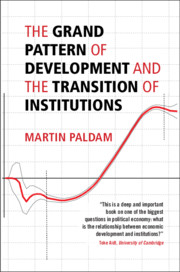Book contents
- The Grand Pattern of Development and the Transition of Institutions
- The Grand Pattern of Development and the Transition of Institutions
- Copyright page
- Contents
- Figures
- Tables
- Preface
- Part I Main Ideas
- Part II The Transitions of Institutions
- Part III The Grand Transition
- Contents
- 12 The Hump-Shaped Transition Path for the Growth Rate
- 13 Do Improvements of Institutions Harm Development?
- 14 Conclusions
- References
- Index
12 - The Hump-Shaped Transition Path for the Growth Rate
from Part III - The Grand Transition
Published online by Cambridge University Press: 07 August 2021
- The Grand Pattern of Development and the Transition of Institutions
- The Grand Pattern of Development and the Transition of Institutions
- Copyright page
- Contents
- Figures
- Tables
- Preface
- Part I Main Ideas
- Part II The Transitions of Institutions
- Part III The Grand Transition
- Contents
- 12 The Hump-Shaped Transition Path for the Growth Rate
- 13 Do Improvements of Institutions Harm Development?
- 14 Conclusions
- References
- Index
Summary
The transition of the growth rate differs from the other transitions, as it has a first difference variable on the vertical axis. Hence, it is very fuzzy, but as the full sample consists of 10,329 observations, a clear pattern is found. It is hump-shaped, so that middle-income countries catch up with the high-income countries. However, the speed of the catch-up is slow. The hump-shape it rather robust. The hump-shape implies that low-income countries diverge and high-income countries converge, just as they do in all seven institutional indices. The hump-shaped transition curve is inconsistent with the one-sector Solow model that has been the workhorse model in the literature over the last 30 years. However, it is easy to explain by the two-sector models of development that used to be common. Two-sector models also show why miracle growth is possible, though difficult to reach.
Keywords
Information
- Type
- Chapter
- Information
- Publisher: Cambridge University PressPrint publication year: 2021
